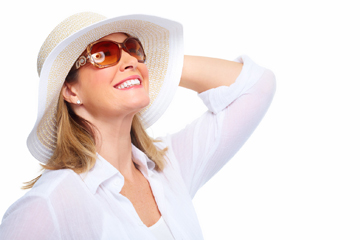July is observed as Ultraviolet Light (UV) Safety Awareness Month to raise awareness about how important it is to protect your eyes and skin from harmful UV rays. Through its EyeSmart campaign, the American Academy of Ophthalmology reminds public of the importance of protecting their eyes from the sun’s harmful rays and urges them to shield their eyes from the sun’s harmful rays with 100% UV-blocking sunglasses and broad-brimmed hats.
UV radiations are invisible rays that are part of the energy that comes from the sun. We all know long-term exposure to the sun’s UV rays can cause damage to the skin, but it can also severely damage the eyes. These rays are responsible for causing corneal damage, cataracts, melanoma of the eye, macular degeneration, growths on the eye, and a rare form of eye cancer. These eye diseases can impair your sight and eventually cause complete vision loss. Even short-term exposure of UV rays can damage the eyes, resulting in photokeratitis which causes redness, blurry vision, sensitivity to bright light, and in rare cases, even temporary vision loss.
Taking the necessary precautions when you are outdoors in summer can help prevent these diseases. Here are the steps you can take to protect your eyes from the sun:
- Limit Exposure: Avoid too much exposure to the sun on warm summer days.
- Ensure proper protection: Wear sunglasses that block 99 to 100 percent of both UVA and UVB radiation and/ or wear a hat and cap with a wide brim. When you are outdoors, take breaks in the shade.
- Get regular checkups: Many eye diseases are treatable if diagnosed early. So, get regular eye checkups done. This protect your eyes from developing diseases, and also provide you with an accurate prescription for glasses or contact lenses.
When buying sunglasses, the American Academy of Ophthalmology recommends choosing substance over style. Here are some tips to choose the right option:
- Look for a sticker or tag indicating that the product can block 99 to 100 percent of both UVA and UVB radiation.
- Buy sunglasses that provide more coverage. Choose oversized glasses or wraparound-style glasses, which help cut down on UV entering the eye from the side.
- Remember that dark lenses may look cool, but may not necessarily block more UV rays.
- Don’t focus on color or darkness of sunglass lenses or be deceived by cost. Select sunglasses that block UV rays. The ability to block UV light is not dependent on the price tag or how dark the sunglass lenses are.
- Use your sunglasses even if you wear contact lenses with UV protection.
- Consider polarized lenses. Polarization reduces glare coming off reflective surfaces like water or pavements. This does not offer more protection from the sun, but can make activities like driving or being in the water safer and more enjoyable.
- Athletes who play sports such as baseball or golf should consider getting sunglasses that come with amber, green or gray lenses. These lenses do not block more sun rays, but they can increase contrast, which may be useful when playing such sports.
- Don’t be fooled by clouds because the sun’s rays can pass through haze and thin clouds. Sun damage to eyes can occur anytime during the year, not just in summer.
- Avoid exposure to the sun during peak hours (between 10 am and 4 pm when the UV radiation is the strongest). Avoid higher altitudes, where UV light is more intense.
- Never look directly at the sun, especially during an eclipse, as it can lead to solar retinopathy – damage to the eye’s retina from solar radiation.
Adults and children share same level of risk if eyes are not protected. So make sure to protect your kids’ eyes with hats and sunglasses. Keep children indoors during peak sun hours.
